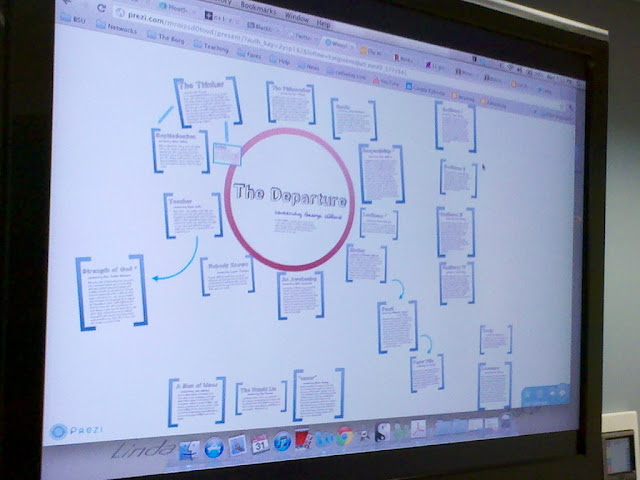This week, we read and discussed Winesburg, Ohio in my Linked Stories workshop. Oh, how I love this book. I wrote about it here.
In my class, we "reverse storyboard" the books we're reading, to take them apart, mix them up, arrange, rearrange, and put them back together again. I don't think there's any better way to learn how to structure your own collection than to mess around with the order of a published book in order to learn what makes it tick, how different orders produce different effects and can provide an entirely different reading experience.
Last week, we turned the poems of Spoon River Anthology into detached, movable pieces. This was easy. I just printed the poems on separate pieces of paper. The poems themselves are thumbnail sketches or screen shots.
When you're trying to reverse storyboard a work of fiction, you have to distill each chapter/story down into that thumbnail or screen shot. The thumbnail can be a physical artifact (using Post its, index cards, posterboard, the blackboard) or a digital one (using Scrivener, Corkboard.me, Power Point, or Prezi). No matter how you do it, the storyboard must be visual, and there must be some logic to how you arrange it so we can "see" the entire structure of the book somehow.
One of my students, Kat Greene, used the presentation software Prezi to storyboard Winesburg. Here she is, walking us through the thumbnails, or in Prezi-speak, "frames."
Basically, she typed up brief paragraph-long synopses of each story and decided on an arrangement that involves the degree to which each story is related to George Willard, the "through line" of Winesburg, Ohio. The big red circle is George, and the one story that's all about him is the very last story in the book, "Departure."
As you can see, most of the stories "revolve" around George Willard--literally. The four stories sitting off to the right side, that's "Godliness," a four-part story that never mentions George; it doesn't totally "fit" into Winesburg, and you can actually see that in the Prezi. Other "loose" stories on the screen are those in which George Willard isn't really mentioned, but as you can see, the stories in which he plays a role as a character far outnumber the number of stories in which he doesn't--which is one of the main reasons the book reads more like a novel than a collection of disparate short stories.
Next week, we're reading Evan S. Connell's Mrs. Bridge, a book widely regarded as a novel, but what I find interesting about it formally is that it's comprised of 117 individually titled vignettes. It will be interesting to compare it to Winesburg.
In my class, we "reverse storyboard" the books we're reading, to take them apart, mix them up, arrange, rearrange, and put them back together again. I don't think there's any better way to learn how to structure your own collection than to mess around with the order of a published book in order to learn what makes it tick, how different orders produce different effects and can provide an entirely different reading experience.
Last week, we turned the poems of Spoon River Anthology into detached, movable pieces. This was easy. I just printed the poems on separate pieces of paper. The poems themselves are thumbnail sketches or screen shots.
When you're trying to reverse storyboard a work of fiction, you have to distill each chapter/story down into that thumbnail or screen shot. The thumbnail can be a physical artifact (using Post its, index cards, posterboard, the blackboard) or a digital one (using Scrivener, Corkboard.me, Power Point, or Prezi). No matter how you do it, the storyboard must be visual, and there must be some logic to how you arrange it so we can "see" the entire structure of the book somehow.
One of my students, Kat Greene, used the presentation software Prezi to storyboard Winesburg. Here she is, walking us through the thumbnails, or in Prezi-speak, "frames."
Basically, she typed up brief paragraph-long synopses of each story and decided on an arrangement that involves the degree to which each story is related to George Willard, the "through line" of Winesburg, Ohio. The big red circle is George, and the one story that's all about him is the very last story in the book, "Departure."
 |
| Winesburg, Ohio storyboard on Prezi |
As you can see, most of the stories "revolve" around George Willard--literally. The four stories sitting off to the right side, that's "Godliness," a four-part story that never mentions George; it doesn't totally "fit" into Winesburg, and you can actually see that in the Prezi. Other "loose" stories on the screen are those in which George Willard isn't really mentioned, but as you can see, the stories in which he plays a role as a character far outnumber the number of stories in which he doesn't--which is one of the main reasons the book reads more like a novel than a collection of disparate short stories.
Next week, we're reading Evan S. Connell's Mrs. Bridge, a book widely regarded as a novel, but what I find interesting about it formally is that it's comprised of 117 individually titled vignettes. It will be interesting to compare it to Winesburg.






